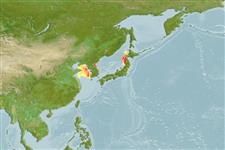Classification / Names
आम नाम | उपशब्द | Catalog of Fishes(वर्ग, प्रजाति) | ITIS | CoL | WoRMS | Cloffa
>
Callionymiformes (Dragonets) >
Callionymidae (Dragonets)
Etymology: Callionymus: Greek, kallion, comparative of kallos = beautiful + Greek, onyma = name; with a better name ; leucopoecilus: From the Greek word 'leucos' meaning white, light and 'poecilos' meaning spotted, referring to the numerous light spots on the dorsal parts of the head and body..
More on authors: Fricke & Lee.
Environment: milieu / climate zone / depth range / distribution range
पारिस्थितिकी
समुद्री ड़िमरसल. Temperate
Northwest Pacific: Korea.
आकार / वज़न / Age
Maturity: Lm ? range ? - ? cm
Max length : 8.4 cm SL पुल्लिंग / अलिंग; (Ref. 11665); 7.9 cm SL (female)
Life cycle and mating behavior
Maturities | पुनरुत्पत्ति | Spawnings | Egg(s) | Fecundities | लार्वा
Fricke, R. and C.-L. Lee, 1993. Callionymus leucopoecilus, a new dragonet (Callionymidae) from the Yellow Sea. Jap. J. Ichthyol. 39(4):275-279. (Ref. 11665)
IUCN Red List Status (Ref. 130435)
Threat to humans
Harmless
Human uses
साधन
Special reports
Download XML
इंटरनेट स्रोत
Estimates based on models
Preferred temperature (Ref.
123201): 4.9 - 14.6, mean 10.3 °C (based on 13 cells).
Phylogenetic diversity index (Ref.
82804): PD
50 = 0.5000 [Uniqueness, from 0.5 = low to 2.0 = high].
Bayesian length-weight: a=0.00912 (0.00408 - 0.02036), b=2.77 (2.59 - 2.95), in cm total length, based on LWR estimates for this Genus-body shape (Ref.
93245).
Trophic level (Ref.
69278): 3.2 ±0.4 se; based on size and trophs of closest relatives
लौटाव (Ref.
120179): ऊंचा, न्यूनतम जनसंख्या दुगनी समय अवलागत 15 महीने। (Preliminary K or Fecundity.).
Fishing Vulnerability (Ref.
59153): Low vulnerability (10 of 100).
